The Art Institute of Chicago
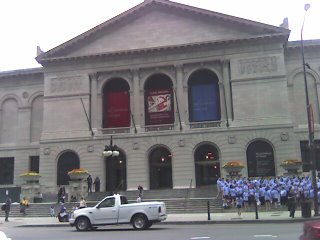 Chicago's version of my favorite museum, New York's Metropolitian Museum of Art is called the Art Institute of Chicago, and it is amazing. Located on South Michigan Avenue and Adams Street, it houses various sets of impressive collections.
Chicago's version of my favorite museum, New York's Metropolitian Museum of Art is called the Art Institute of Chicago, and it is amazing. Located on South Michigan Avenue and Adams Street, it houses various sets of impressive collections. The Art Institute displays a wide variety of art forms from multiple time periods, like this Northern Italian suit of armor from 1600. The Harding Collection of Arms and Armor, composed of more than 1,500 objects dating from the 15th through the 19th centuries, is one of the largest in the United States. The permanent exhibition of 225 objects contains items from Europe and the Middle East with various kinds of weapons and defensive gear.
The Art Institute displays a wide variety of art forms from multiple time periods, like this Northern Italian suit of armor from 1600. The Harding Collection of Arms and Armor, composed of more than 1,500 objects dating from the 15th through the 19th centuries, is one of the largest in the United States. The permanent exhibition of 225 objects contains items from Europe and the Middle East with various kinds of weapons and defensive gear.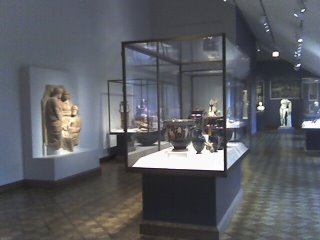 They have a very nice ancient Greek and Roman collection.
They have a very nice ancient Greek and Roman collection. I was struck by this marble "Funerary Stele (Grave Marker) from 330 B.C.
I was struck by this marble "Funerary Stele (Grave Marker) from 330 B.C. This Roman work dating 140-50 A.D. is probably of a woman of some importance.
This Roman work dating 140-50 A.D. is probably of a woman of some importance. This dish made a couple of hundred years before Christ is a fine example of the ancient Greeks' use of browns and orange colors. It is truly amazing how well they have held up over the years.
This dish made a couple of hundred years before Christ is a fine example of the ancient Greeks' use of browns and orange colors. It is truly amazing how well they have held up over the years. The thing I was most impressed with about the Art Institute was it's collection of Christian-themed art. Its display of objects like this "Corpus of Christ" by Melchior Broederlam is much more varied and in depth than the Met in New York. This Spanish work dates to the second half of the 12th Century.
The thing I was most impressed with about the Art Institute was it's collection of Christian-themed art. Its display of objects like this "Corpus of Christ" by Melchior Broederlam is much more varied and in depth than the Met in New York. This Spanish work dates to the second half of the 12th Century. This photo of the Ayala Altarpiece from 1396 does not do it justice.
This photo of the Ayala Altarpiece from 1396 does not do it justice.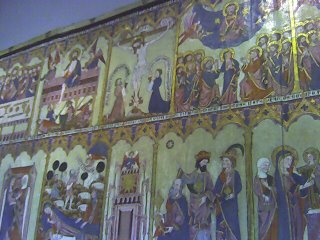 It is made up of 15 scenes, or mini-paintings, about the life of Christ.
It is made up of 15 scenes, or mini-paintings, about the life of Christ. The museum also has an architecture area, which includes a screen made in 1952 that was designed by Frank Lloyd Wright. Wright seems to be the only architect anyone has ever heard of even though I know very few people who'd want to live in one of his homes.
The museum also has an architecture area, which includes a screen made in 1952 that was designed by Frank Lloyd Wright. Wright seems to be the only architect anyone has ever heard of even though I know very few people who'd want to live in one of his homes. The impressive collection expands into the art of America, before and after the Europeans came. The department includes more than 1,000 paintings and sculptures from the 18th century to 1950 and nearly 2,500 decorative art objects from the 17th century to present.
The impressive collection expands into the art of America, before and after the Europeans came. The department includes more than 1,000 paintings and sculptures from the 18th century to 1950 and nearly 2,500 decorative art objects from the 17th century to present.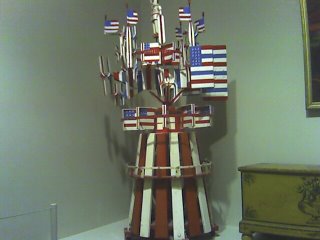 "Whirligig entitled America" by Frank Memkus from 1938/42 is made up of wood and metal. Whirligigs are wind powered forms. This must have been made at a time when artists were allowed to love America. USA! USA!
"Whirligig entitled America" by Frank Memkus from 1938/42 is made up of wood and metal. Whirligigs are wind powered forms. This must have been made at a time when artists were allowed to love America. USA! USA!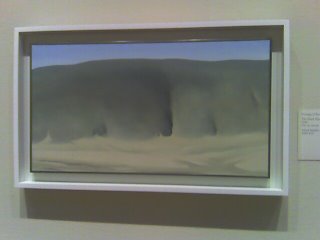 Georgia O'Keeffe's "The Black Place" (1943) caught my eye even though it's seemingly just a painting of sand. She has a beautiful way of capturing landscapes.
Georgia O'Keeffe's "The Black Place" (1943) caught my eye even though it's seemingly just a painting of sand. She has a beautiful way of capturing landscapes. Being that I've been to Harlem, I was a big fan of Archibald J. Motley, Jr.'s "Nightlife," made in 1943. Interestingly enough, while he is associated with the Harlem renaissance, Motley never actually spent time there.
Being that I've been to Harlem, I was a big fan of Archibald J. Motley, Jr.'s "Nightlife," made in 1943. Interestingly enough, while he is associated with the Harlem renaissance, Motley never actually spent time there. Perhaps my favorite painting in the museum is this one, "The Rock" by Peter Blume (1944-48). It shows signs of construction on the left and evidence of destruction on the right.
Perhaps my favorite painting in the museum is this one, "The Rock" by Peter Blume (1944-48). It shows signs of construction on the left and evidence of destruction on the right.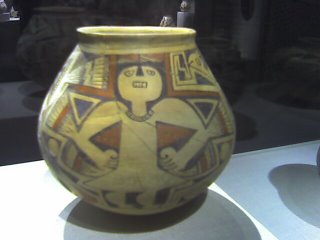 This vase was part of a temporary exhibit titled "Casas Grandes and the Ceramic Art of the Ancient Southwest," which features work by Indian communities of the American Southwest and Northwestern Mexico dating 1200-1400 A.D.
This vase was part of a temporary exhibit titled "Casas Grandes and the Ceramic Art of the Ancient Southwest," which features work by Indian communities of the American Southwest and Northwestern Mexico dating 1200-1400 A.D.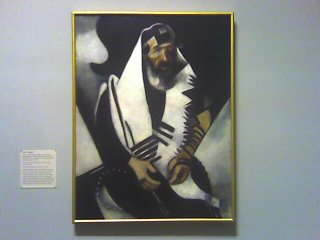
Marc Chagall's "The Praying Jew" (this is a 1923 copy of a 1914 work) instantly caught my eye.
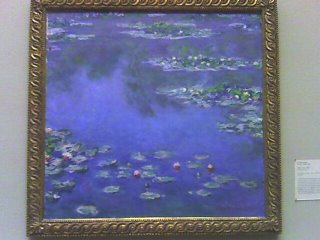 Here's another version of "Water Lilies" by Claude Monet (1906). Monet must have made about two billion of these. A large collection of his work may be found here.
Here's another version of "Water Lilies" by Claude Monet (1906). Monet must have made about two billion of these. A large collection of his work may be found here. My favorite room in the institute however was one with various works of Domenico Theotocopuli, "El Greco" (the Greek). This painting, called "Saint Francis," (1590) is an example of the use of color that normally makes me instantly recognize his work. His faces and clothing tend to be bright, which makes his paintings stick out of the room. And yes, in case you're wondering, I'd like his work even if he wasn't Greek. More of his work may be found here.
My favorite room in the institute however was one with various works of Domenico Theotocopuli, "El Greco" (the Greek). This painting, called "Saint Francis," (1590) is an example of the use of color that normally makes me instantly recognize his work. His faces and clothing tend to be bright, which makes his paintings stick out of the room. And yes, in case you're wondering, I'd like his work even if he wasn't Greek. More of his work may be found here.This is a fabulous museum and one of the true treasures of the city of Chicago. There was so much there that I felt rushed. I probably could have spent a whole day in there.

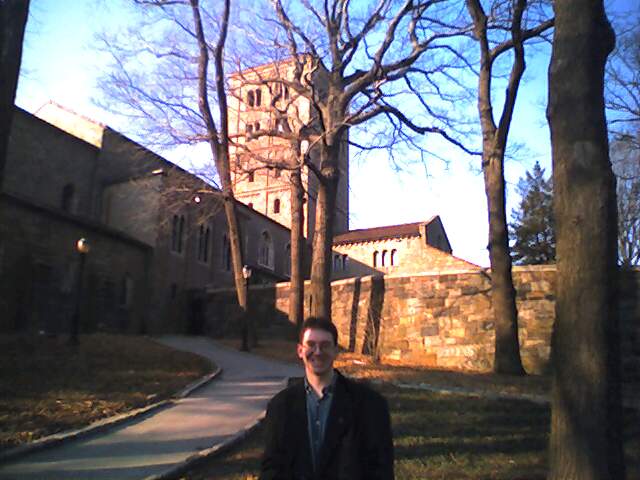

0 Comments:
Post a Comment
|<< Home